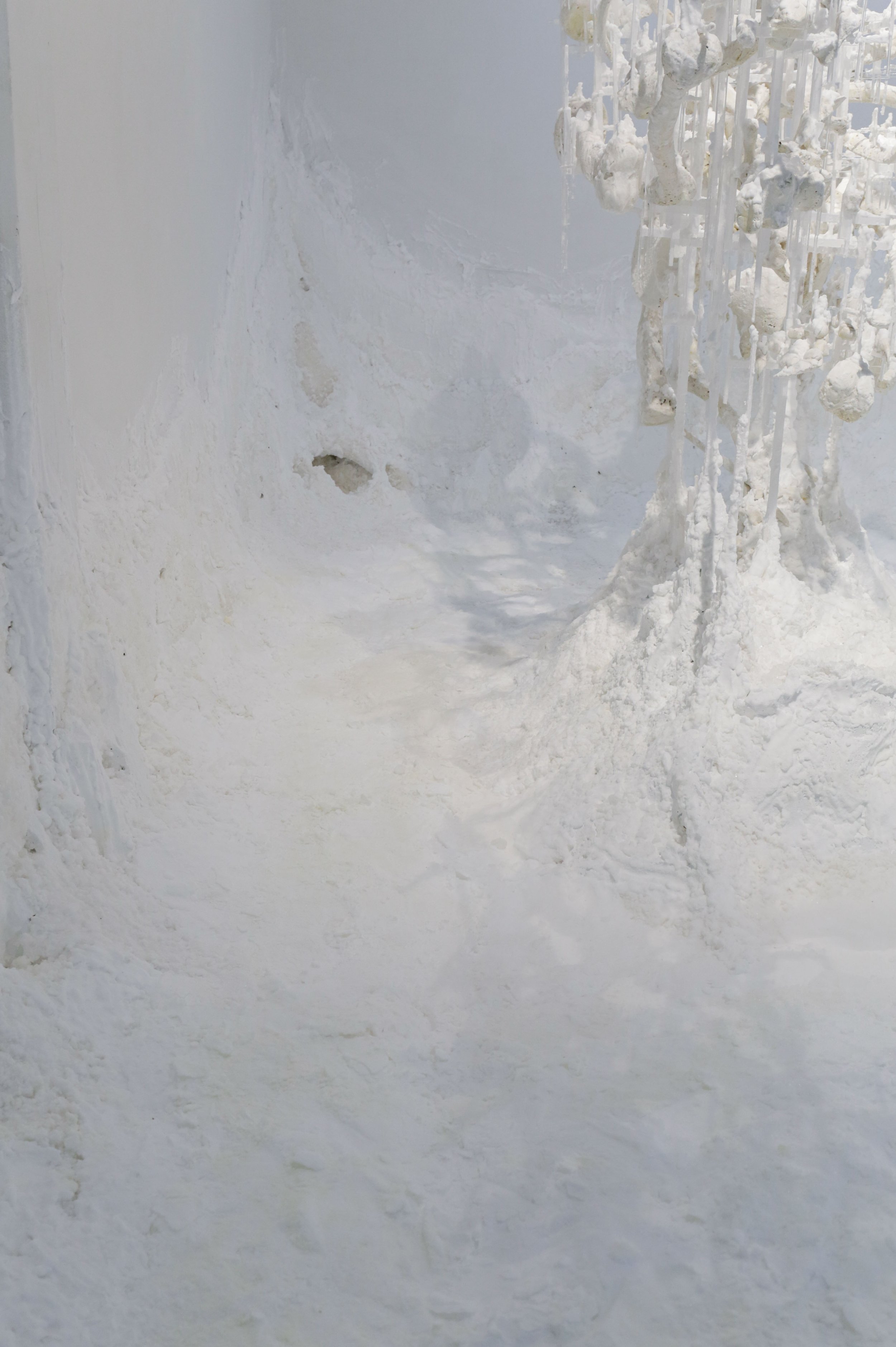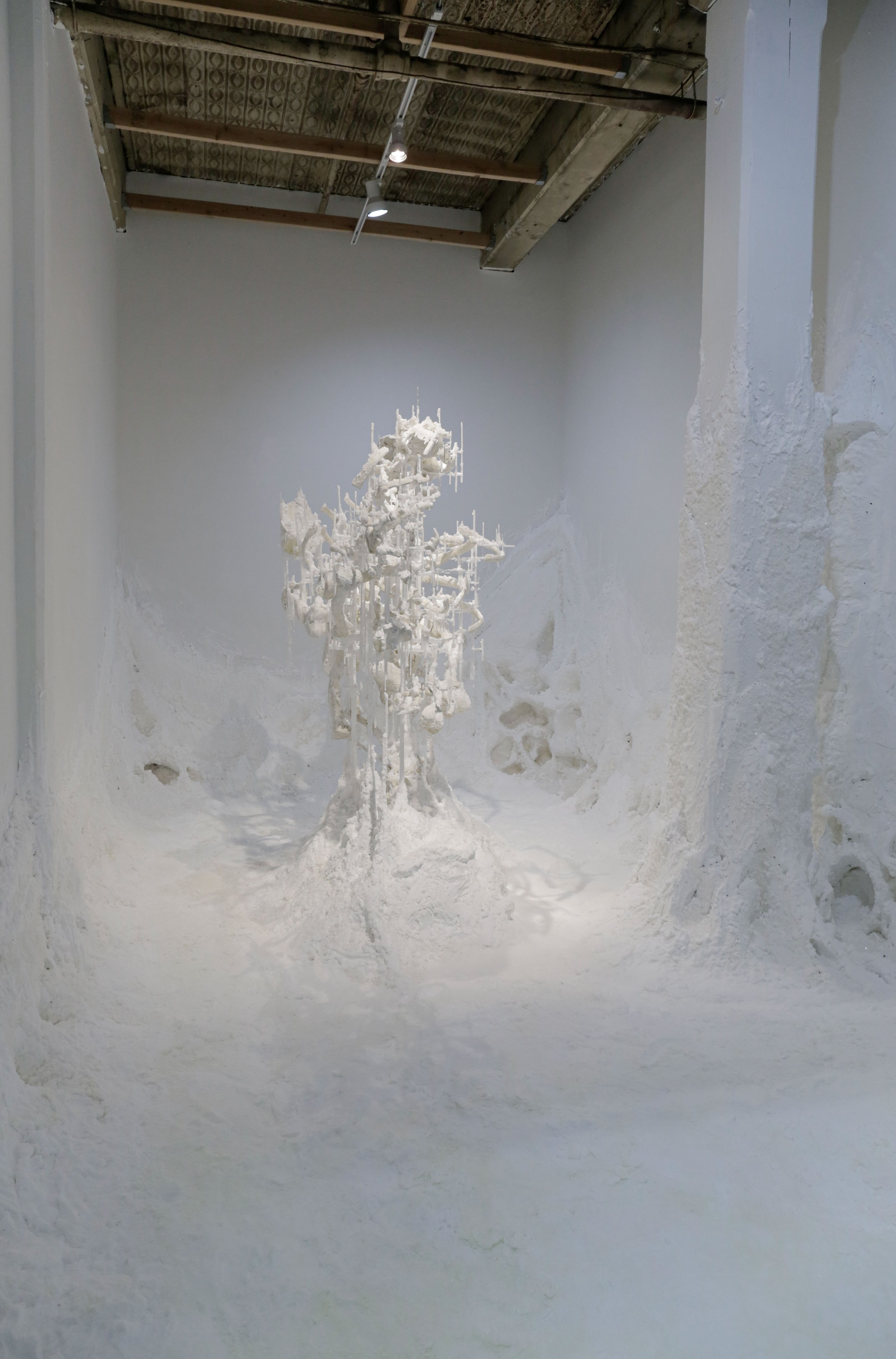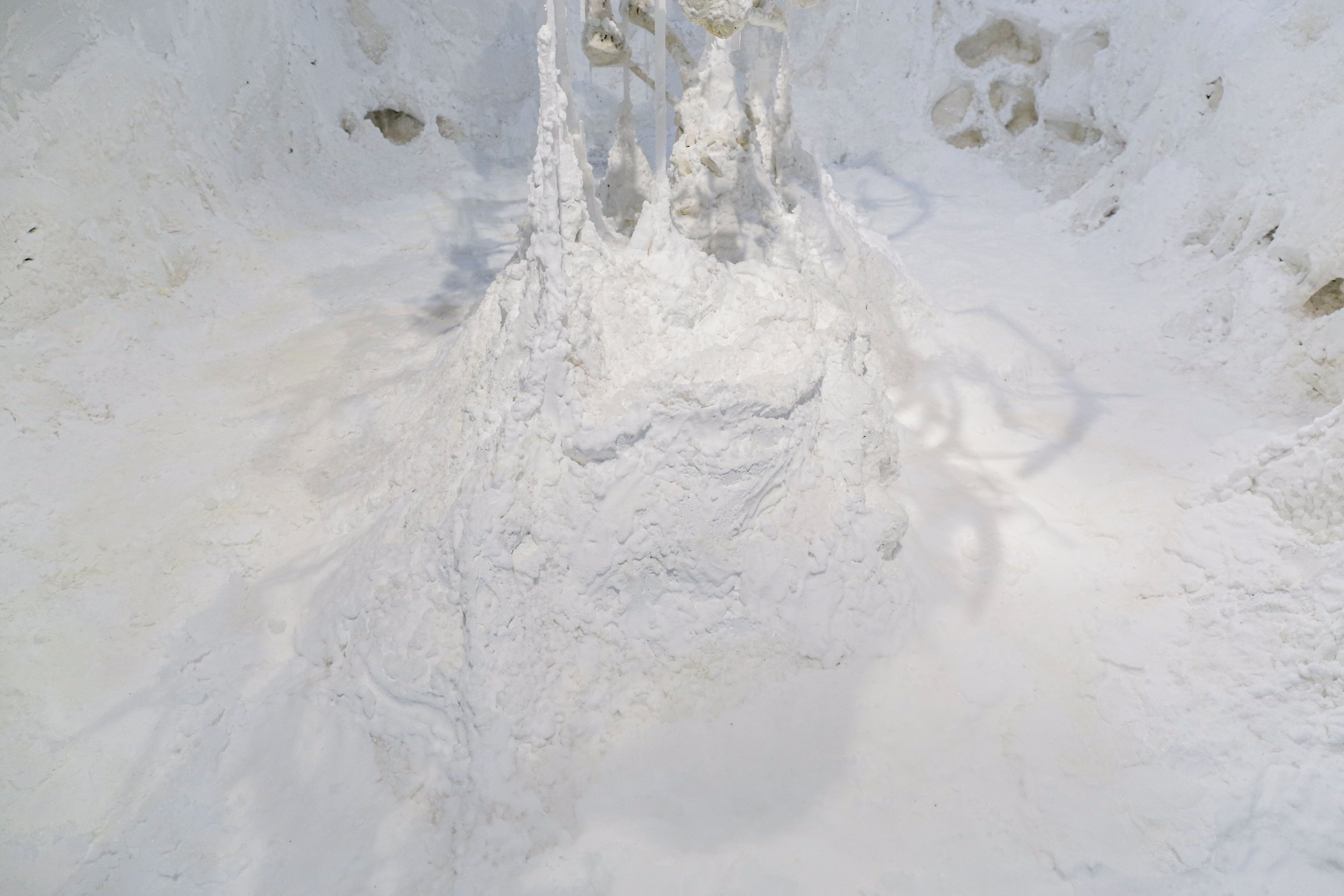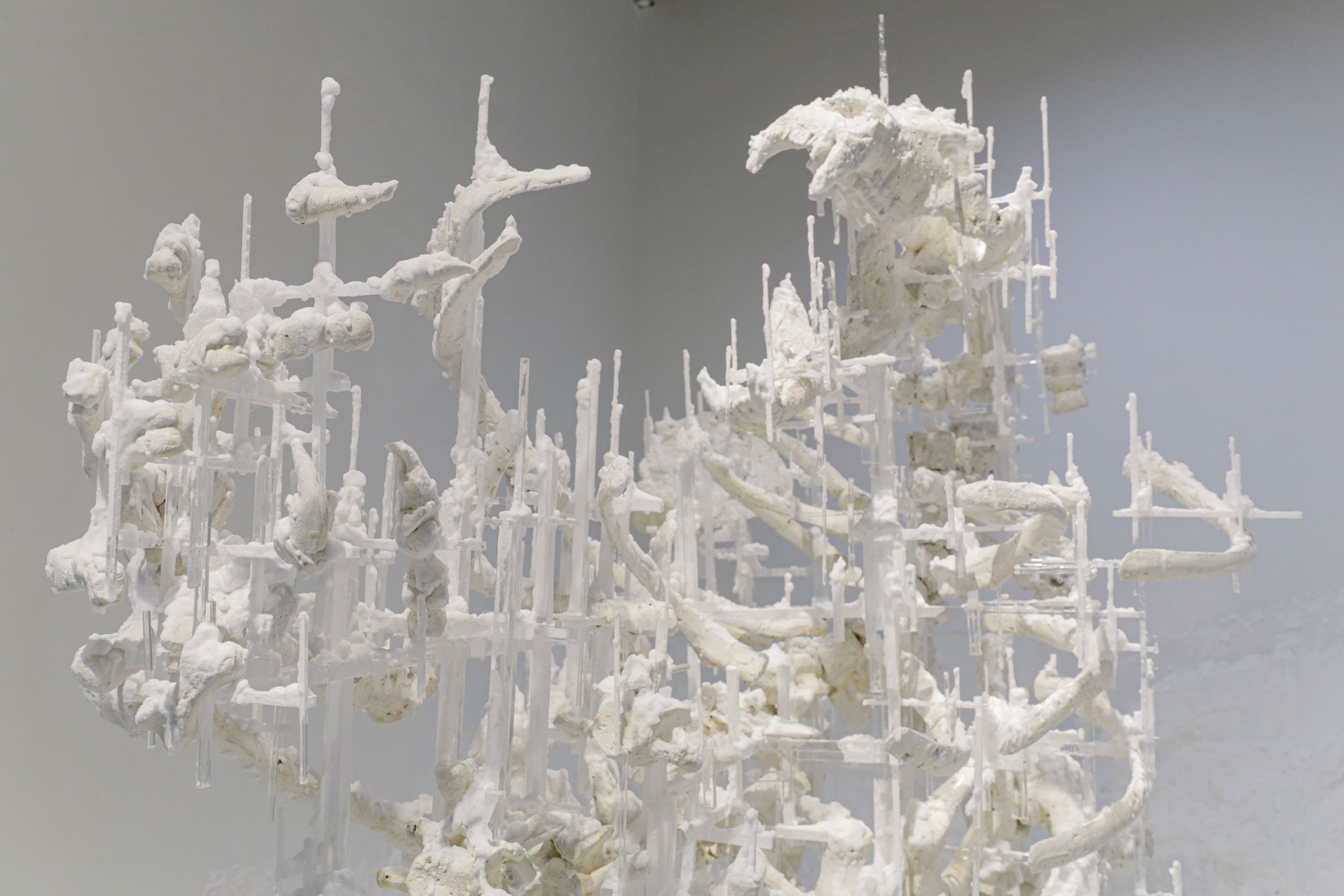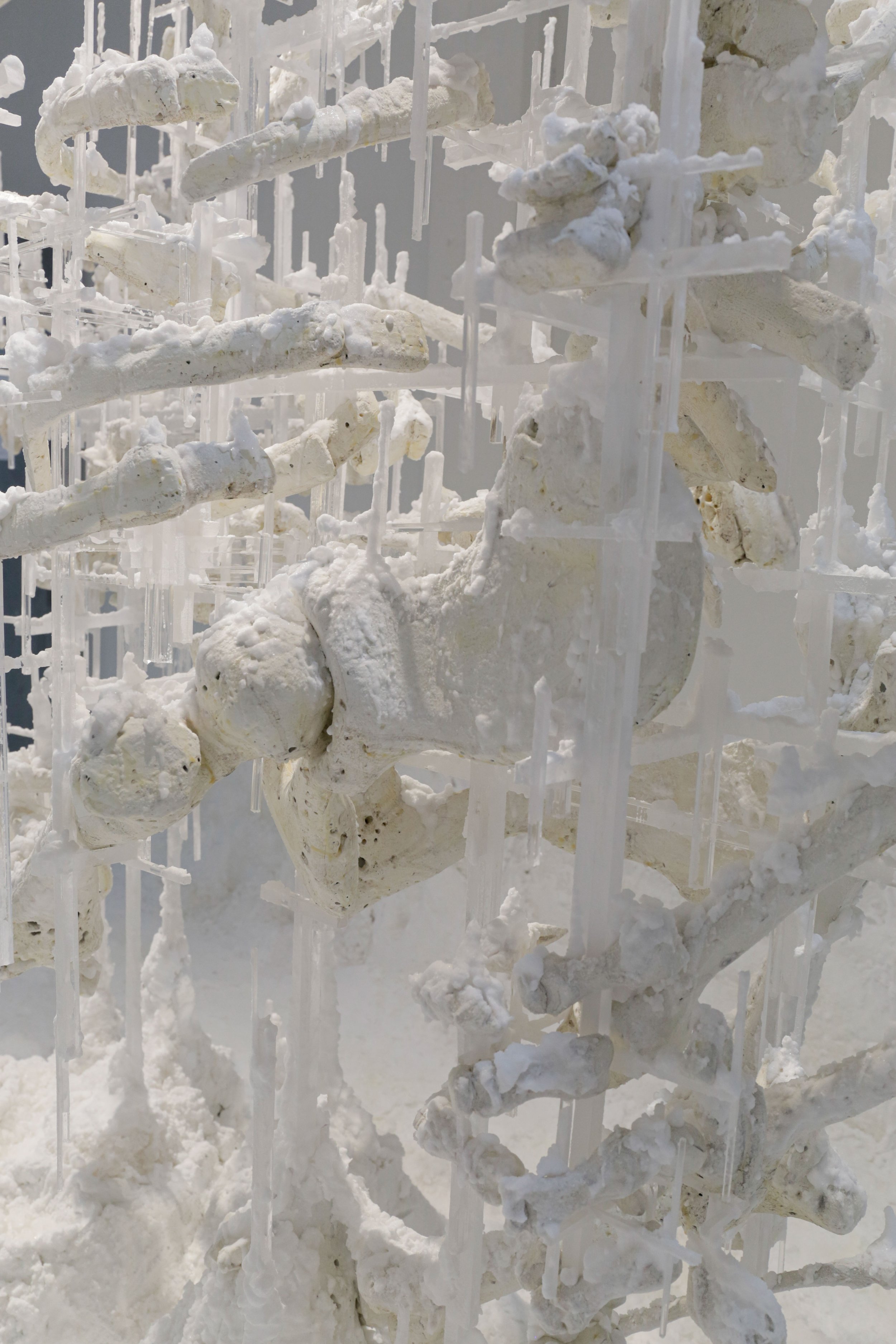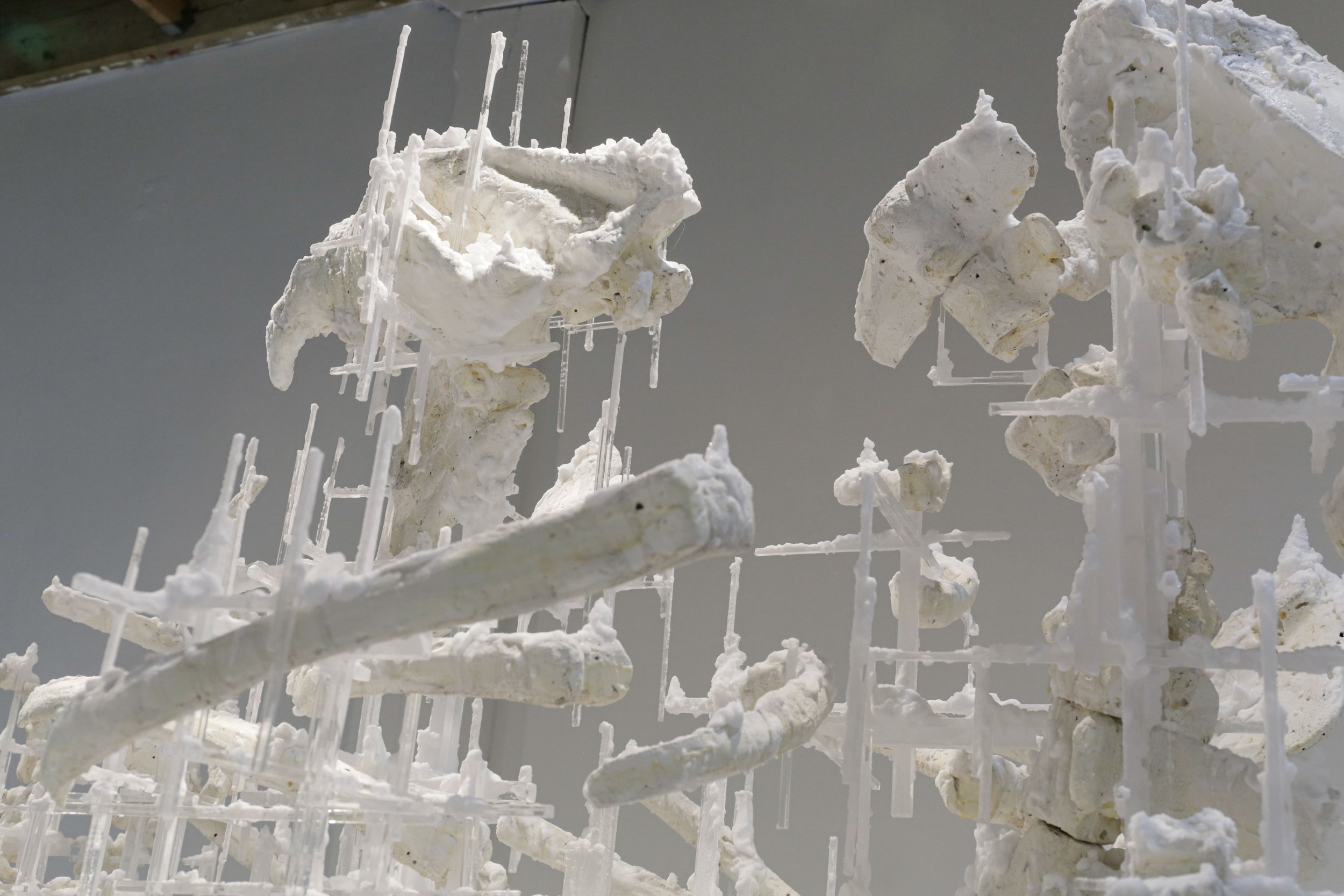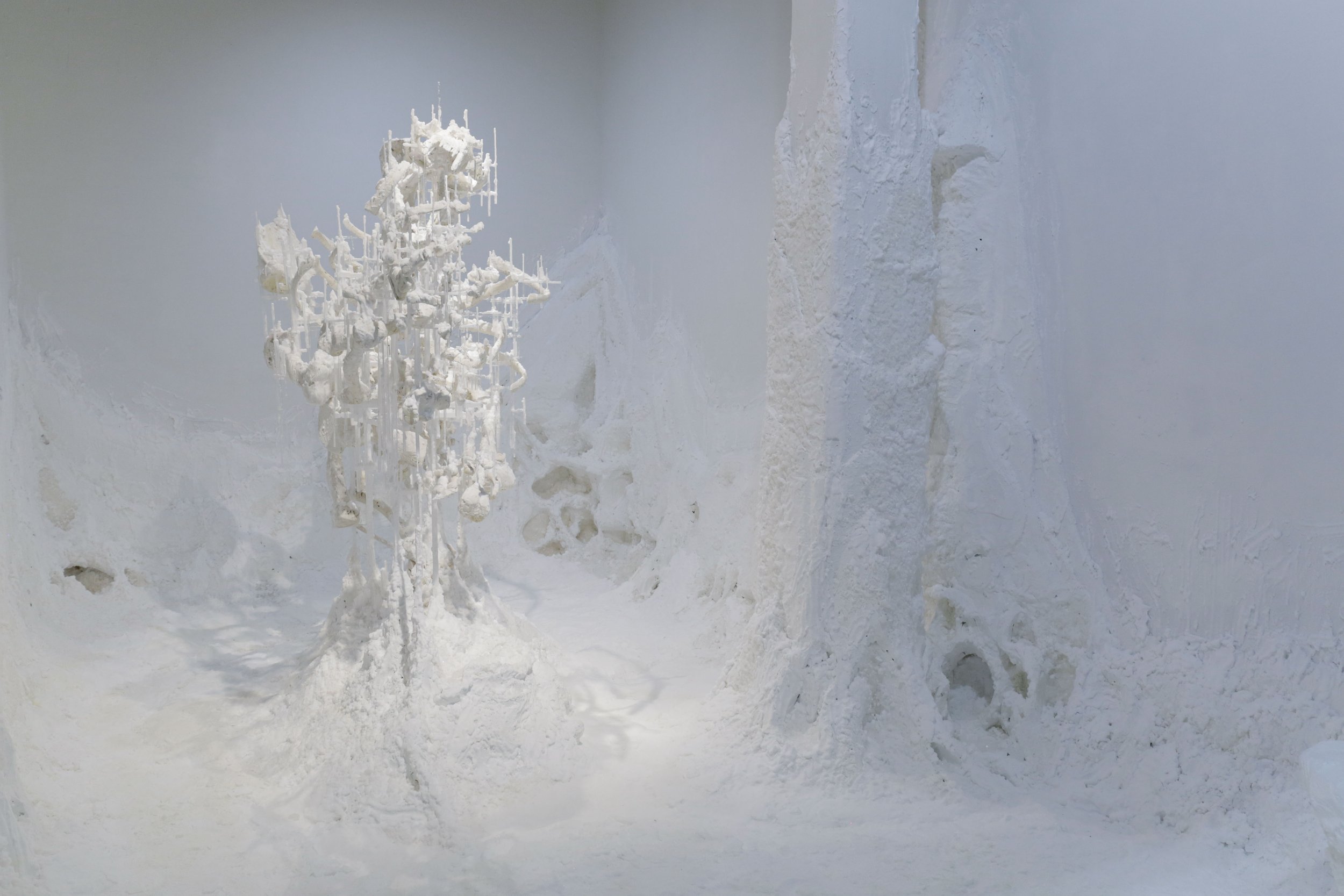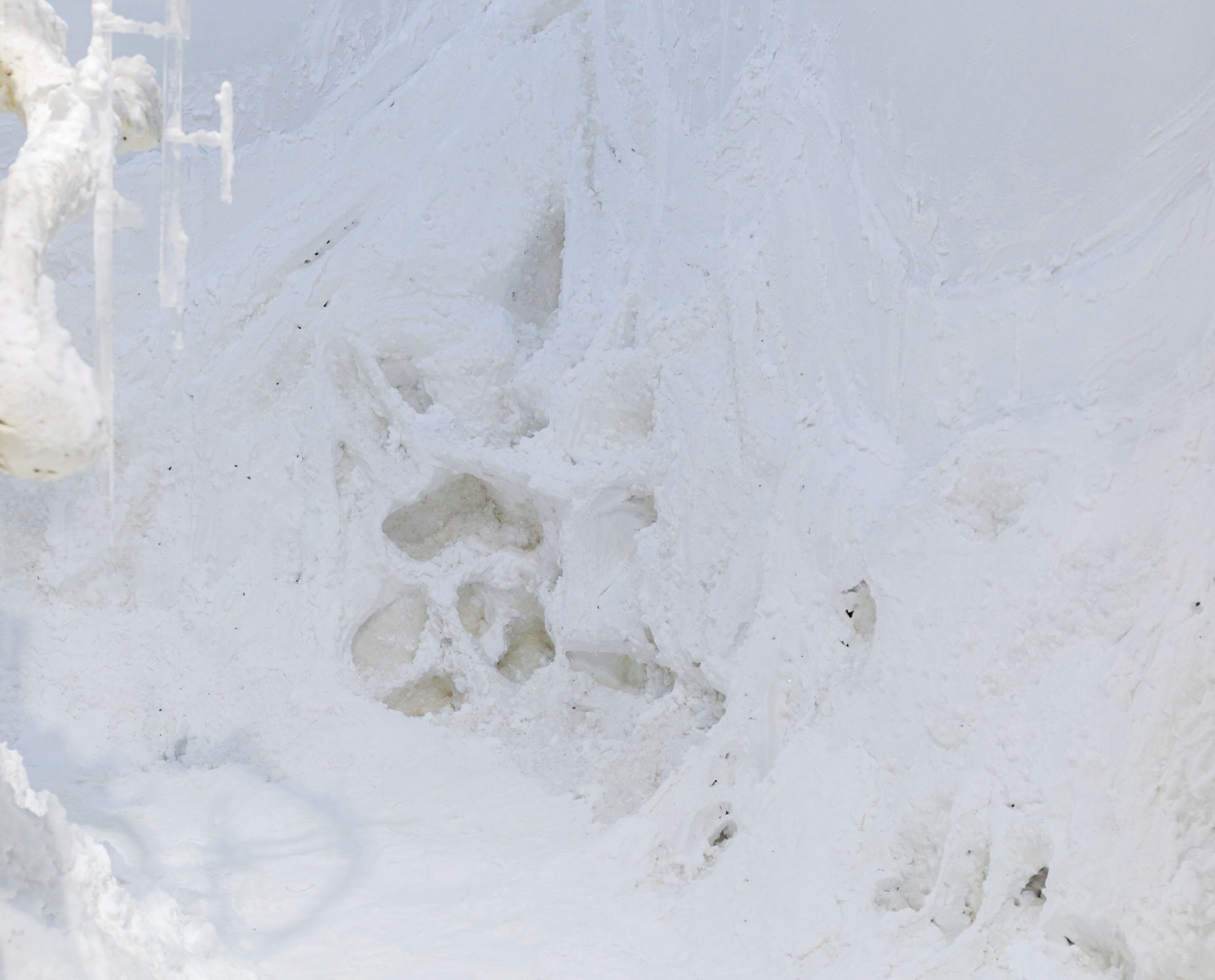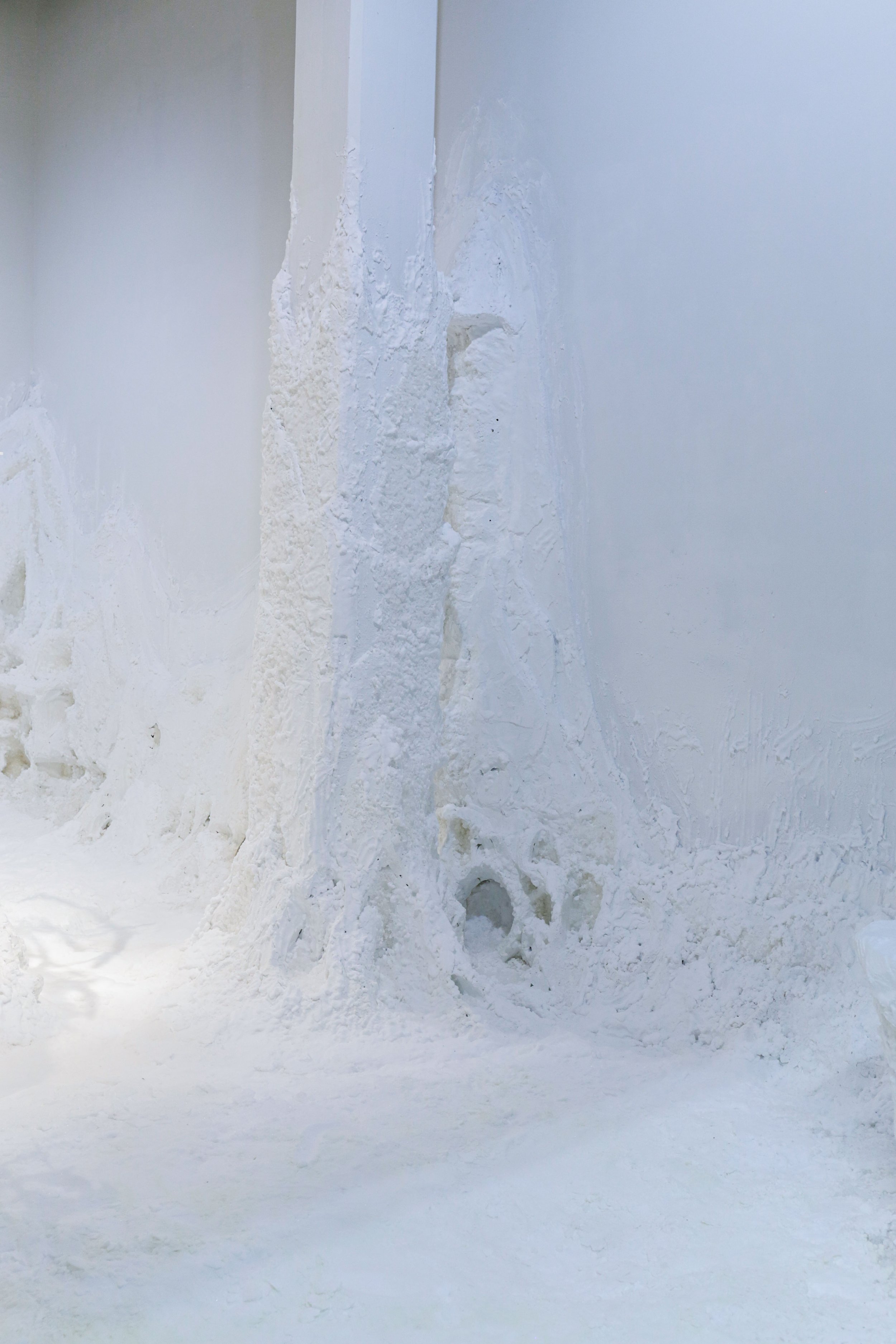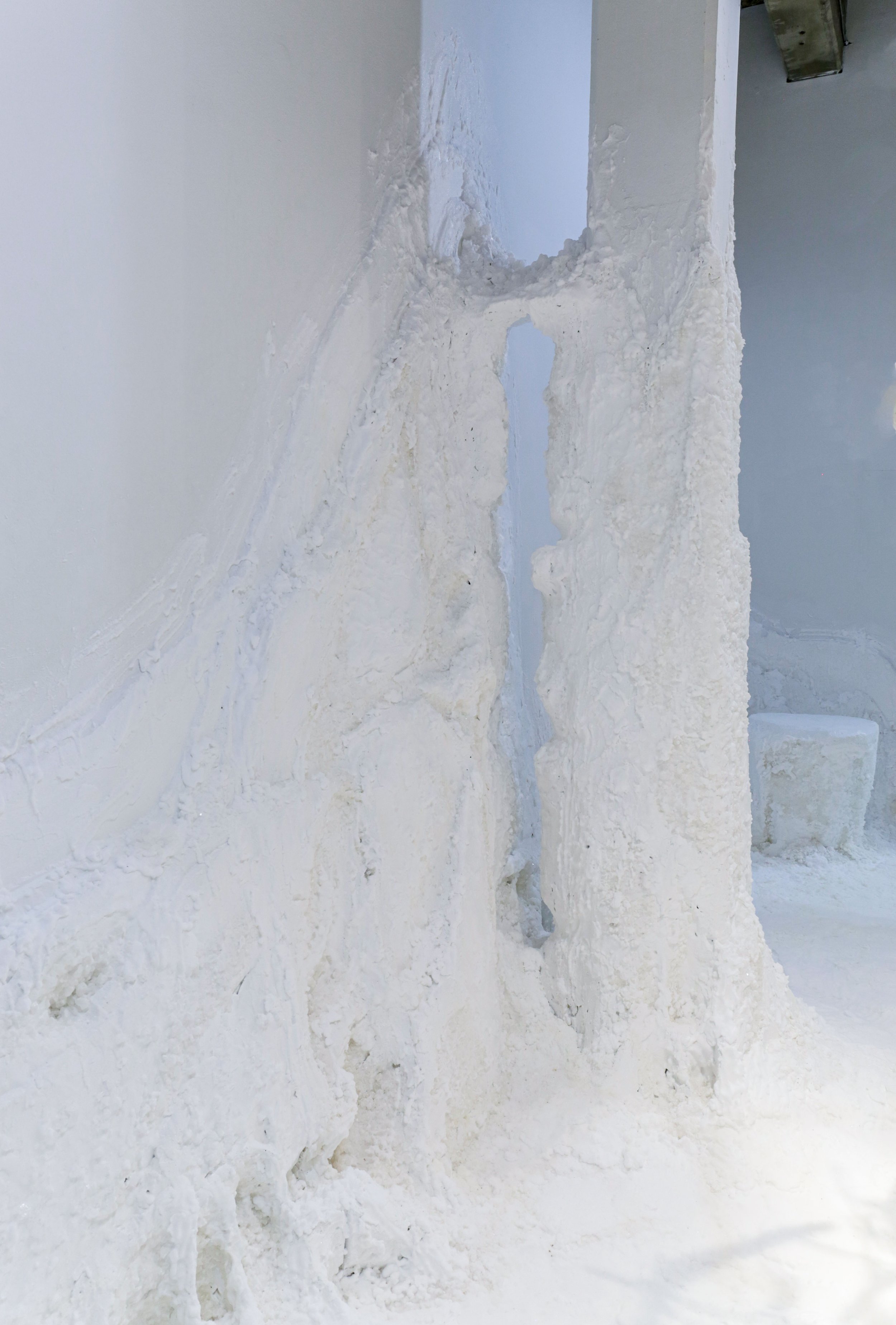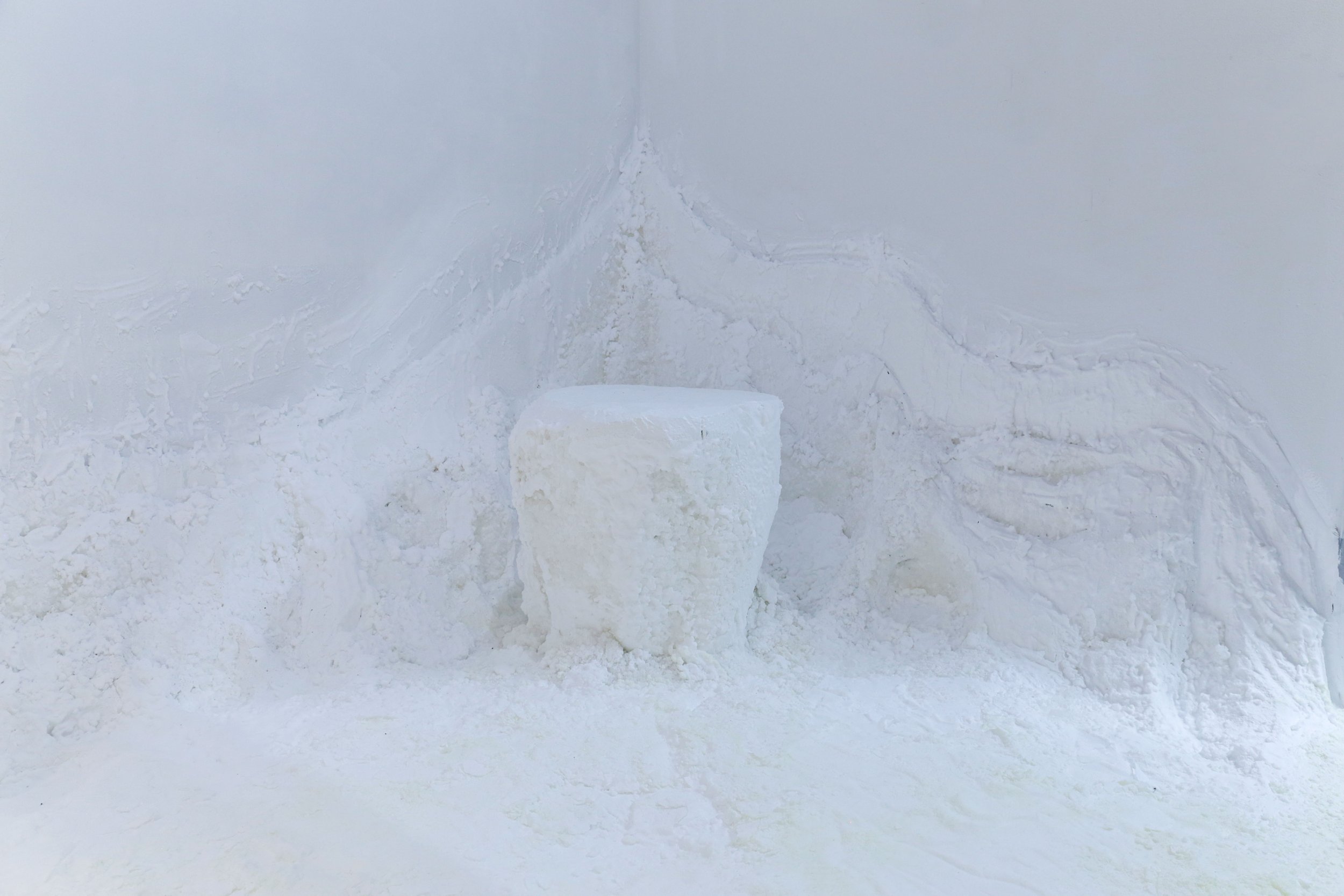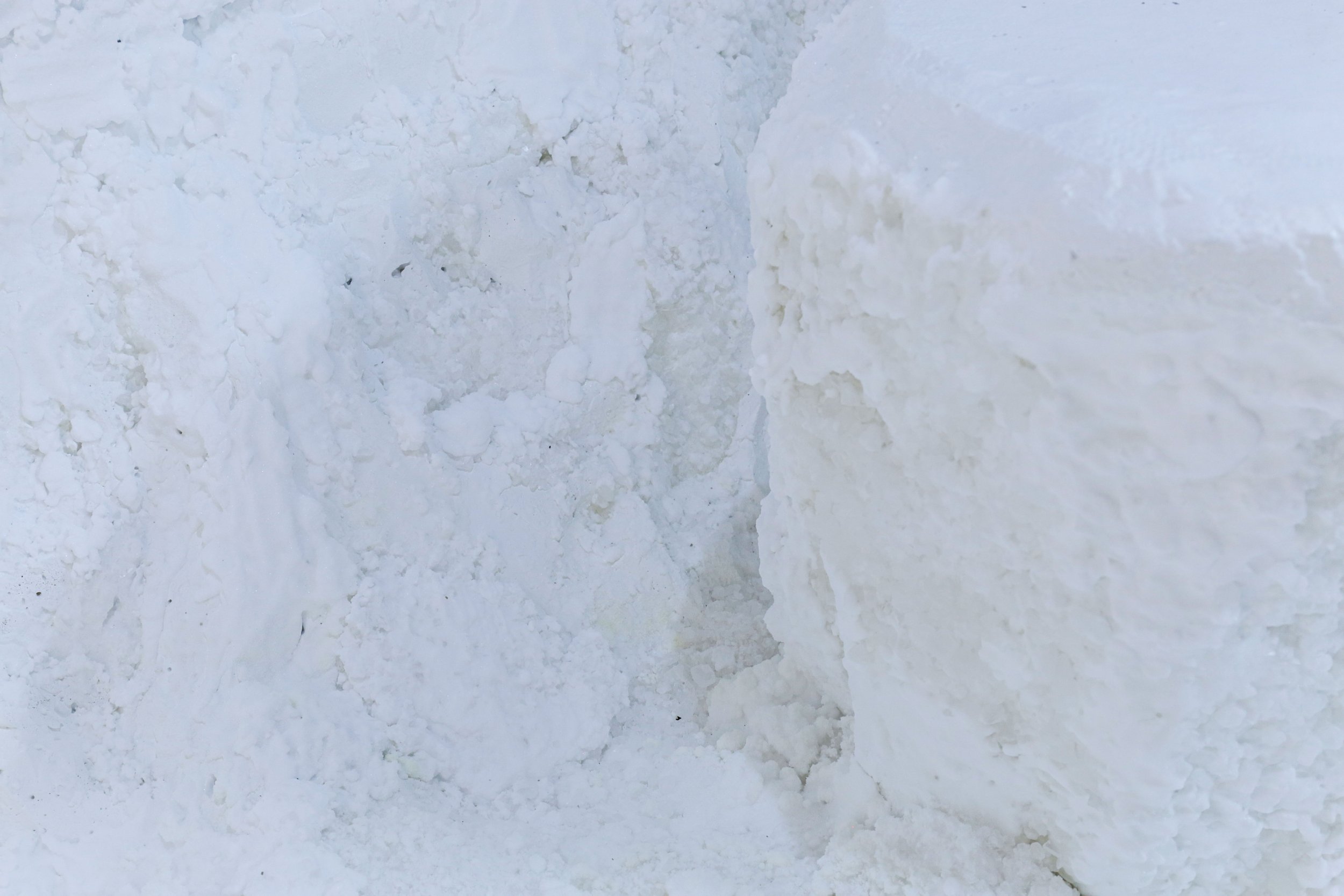An Uninhabitable Space: the Art of Jonathan Latiano Written by Angela McQuillan
“Well, Americans don't care for much of anything
Land and water the least
And animal life is low on the totem pole
With human life not worth more than infected yeast”
- Excerpt from Last Great American Whale by Lou Reed
I first discovered the work of Jonathan Latiano years ago on the internet when I happened upon an image of Points of Contention, a site specific installation at the School 33 Art Center in Baltimore. The white crystalline structure created out of wood, plastic, acrylic, styrofoam, glass, and salt, appears to be bursting out of the floor below it and emerging into the room. I was immediately attracted to the beauty and boldness of the piece, but also the underlying theme—it was a work about the negative environmental effects of plastics and polymers on the global landscape. I contacted Jonathan immediately because I was curating a show loosely-themed around crystalline structure entitled Crystal Beings, and I wanted to commission him to create an installation piece that would be the centerpiece of the exhibition. His work was a perfect fit.
When cold calling anybody you never know what type of response you will get, but Jonathan was immediately receptive to my proposition and started drawing up plans for this new installation entitled Skimming the Riff, planned for the Esther Klein Gallery in Philadelphia in the spring of 2015. During our preliminary drafting meetings Jonathan communicated that he would be constructing his 15-foot installation entirely out of recycled pieces of clear acrylic (discarded from a laser cutter facility), and salt. I had never worked with an artist who used large quantities of salt as a sculptural material, so I was very curious as to what this process was going to look like. When he came to install the piece, he literally brought in buckets full of liquid salt slurry, using it as a binding medium for the sculpture. I had never seen anything like it before, but it worked—and it was genius. Jonathan has a unique and thought-provoking way of sourcing sustainable materials while tying them into his subject matter, which is one of the many layers to uncover in his work.
Fast forward to 2019, I was a member of Grizzly Grizzly and was writing new exhibition proposals for our unique (cozy) space. I love small galleries because they are perfect canvases to be completely transformed, and I was looking for an artist to create an installation that would metamorphose the space into something new and exciting. Jonathan was one of the first people who came to mind for this task, I knew from social media that he had been working on some rad new work using automotive paint, and I can’t resist shiny objects. At this point it had been about four years since our last interaction and a lot had changed about Johnathan's work, but something I love so much as a curator is watching artists grow and develop their practice. In that amount of time Jonathan had completed new and matured work and had countless projects on the horizon, but regardless of his busy schedule he had every intention of fitting in a show at Grizzly Grizzly.
While preparing for his upcoming installation during the global quarantine (in typical Jonathan Latiano-style) he built an entire to-scale replica of the 300-square foot Grizzly Grizzly gallery space in his studio in Boston and started constructing his installation off-site. Every detail was carefully and meticulously considered, from the well-loved but oddly placed pillar in the center gallery, to the position of the power outlets. Each piece of the site-specific installation was created to fit perfectly in the space and to be transported easily. Special care was taken to install a plastic layer underneath the entire installation to thoroughly seal off the one-thousand pounds of salt slurry solution so it didn’t leak through to the floor underneath. A meticulous schedule was prepared in advance to allow enough time for the salt to be completely dry and crystallized for the opening reception.
The timeline for this show kept getting pushed back due to the pandemic. Originally scheduled to open in 2020, the exhibit was extended into 2021 and then postponed again to 2022. During this time, the galleries in the 319 building were closed for exhibitions and collectively turned their galleries into magical creative spaces for artist residencies. During that time of uncertainty, Jonathan got married and I started grad school and left Grizzly Grizzly. There was so much happening and yet everything was stalled like a strange time warp.
Well, here we are in 2022, thankful to still be alive and on the other side of the quarantine.
Finally—the installation is complete, and the show opened in March 2022 at Grizzly Grizzly. All the work and planning were worth it.
It was breathtaking.
In A Polar Bear Drowns in Evaporated Seas, visitors walked into the gallery and were confronted with a completely pristine white and glittering space. Salt crystals were sparkling in every nook and cranny of the room, with little corners and crevices that formed mini caves and formations. The air was crisp—it had a smell of salt and fresh paint, and the shimmering rocks crunched under your feet with every step. In the center of the room was the full, anatomically correct, to-scale skeleton of a polar bear carved out of foam. But it wasn’t arranged like you would expect at a science museum. It was deconstructed and suspended on a grid made of clear acrylic, dripping with salt crystals and telling you what you don’t want to hear but already know.
Salt is a powerful symbol and has historically held many connotations throughout history, both positive and negative. Salt can hold powers of purification—the Bible tells the story of Sodom and Gomorrah who were purified with salt. The mineral was used as a seasoning, as a preservative, to disinfect wounds, and even to ward off evil spirits. Salt also has the power to make water undrinkable, to kill plants, and make humans very sick in large quantities. This dual nature of the mineral proves the point that systems need to remain in balance to be sustainable. Tipping the scales too far one way or the other has the potential to generate death and destruction.
Polar bears have become the ultimate symbols of human destruction on the planet, because they are reliant on sea ice, which is melting at a high rate due to global warming. The ice gives them access to seals which is their primary source of food. With less sea ice every year, polar bears and many other ice-dependent creatures are at risk of extinction. Images portraying a lone polar bear standing on small iceberg have become icons of the global environmental movement and it’s estimated that most polar bears are likely to disappear by 2100 unless climate warming slows significantly. The polar bears are just the metaphorical tip of the iceberg when it comes to the negative effects that climate change has on biodiversity.
The environmental impacts being driven by human induced climate change are changing natural habitats in drastic ways that are still only becoming clear to scientists. Rising temperatures and sea levels, extreme weather patterns and ocean acidifications are putting pressure on many diverse species of the world which have enormous ramifications on our ecosystem and planet as a whole. “If the planet warms by 1.5 degrees Celsius — which is almost certain — up to 14 percent of all plants and animals on land will likely face a high risk of extinction.” 1
Some people may wonder why losing a species even matters. Every species on the planet (including humans) are interconnected, and whether visible to the human eye or not, each species has a very important role to play. Scientific research has revealed that the extinction of one plant or animal species from extreme environmental change increases the risk of an 'extinction domino effect' that could annihilate all life on Earth. "Even the most resilient species will inevitably fall victim to the synergies among extinction drivers as extreme stresses drive ecosystems to collapse." says Evolutionary Biologist Dr Giovanni Strona.
This is not the first piece that Jonathan Latiano has created that was inspired by endangered species. His installation Flight of the Baji, was created in homage to the extinct species of freshwater baji dolphins who were once a thriving part of the Yangtze River ecosystem in China, with the last known member of the species dying 2002. In this installation he created anatomically correct replicas of the dolphin’s skeletons from gathered driftwood that he bleached and carved by hand.
In the interestingly impossible scenario in A Polar Bear Drowns in Evaporated Seas, Jonathan is combining both science-fact and science-fiction. It is a fact that the polar bears are in danger of dying off unless we do something quickly. However, the oceans are not realistically in danger of evaporating. But water is the most important support system for life on earth. Without it, all trees and plants would die out and there would be no more clouds or rain. The entire planet would become a giant dust storm and humans would cease to exist.
Latiano’s white crystalline space is a different type of uninhabitable. The Great Barrier Reef in Australia used to be full of many colors, vibrant and beautiful. Over time the coral has been dying and turning white and bleached due to global warming. A Polar Bear Drowns in Evaporated Seas uses an all-white backdrop to represent the purity and innocence of the animals and organisms that we are destroying, creating a temple of mourning for the species that will soon be lost forever. This white room is sterile and uninhabitable, with no signs of life. The chemical smells and fluorescent lighting only add to this effect – which is something you would have to be physically present to experience. This is a work designed to inspire a moment of reflection, by offering an undesired and symbolic future scenario. We are not there yet, but it is happening right under our noses. There is not much time left. We need to act quickly.
Jonathan Latiano is an incredibly thoughtful artist. This exhibition resonated in its poetic title and the confrontational depiction of the lone polar bear. With rising sea levels and increasing temperatures across our planet, Latiano uses his artistic practice as a tool to interrogate the negative ecological impact humans have on the physical environment. He uses his art as a form of activism and sparks a sense of urgency in the viewer. When Lou Reed released Last Great American Whale in 1989, the song was calling attention to the little regard humans have for our environment and each other. How much has really changed since then? The warnings are constant and abundant if you are paying attention and listening. Who really has the power to make any meaningful changes? Corporations , governments, and to a lesser extent individuals, must lessen their emissions to achieve our global climate goals and protect our wildlife. Ultimately, the responsibility lies in the hands of our policymakers. Let’s hold them accountable.
1 https://www.vox.com/down-to-earth/2022/3/1/22954531/climate-change-ipcc-wildlife-extinction
2 https://www.sciencedaily.com/releases/2018/11/181129122506.htm
Watch a Video Tour of A Polar Bear Drowns in Evaporated Seas here: https://vimeo.com/866411762
Angela McQuillan is an Artist and Curator working at the intersection of art and science. Angela holds degrees in biology and painting, and has ten years of experience working as a scientist in various roles including academic research and pharmaceuticals. To this date, Angela has curated over 50 art exhibitions relating to science and technology, including exhibitions by internationally recognized artists working specifically with biological media. Angela worked as the Curator at the Esther Klein Gallery on Philadelphia from 2014 - 2022, and Co-Founded the University City Science Center’s BioArt Residency at the biotechnology company Integral Molcular in 2017. This residency program recently won the 2019 Art + Business Partnership Award by the Philadelphia Arts & Business Council. Angela’s work has been featured in prominent publications such as The New York Times, Forbes and SciArt in America. She is currently developing the exhibition “Futures Without Guns”, funded by the Pew Center for Arts and Heritage, scheduled to open in 2024.
Jonathan Latiano received his BA in Studio Art from Moravian College in Bethlehem, Pennsylvanian in 2006 and his Masters in Fine Art from the Maryland Institute College of Art in 2012. Jonathan has exhibited in numerous solo and group public art exhibitions in cities including New York, Philadelphia, Baltimore, Washington DC, and London England and his work has been featured in local, national and international art publications. Jonathan’s artistic and teaching practices have earned him multiple honors and awards including the 2013 Mary Sawyers Baker Prize in Art, Moravian College’s 2015 Outstanding Young Alumni Award, and the 2016 Bunting Teaching Fellowship in Fine Arts at the Maryland Institute College of Art.
Jonathan maintains his studio practice in Somerville, Massachusetts, is a member of the Boston Sculptors Gallery, and serves as the Director of the Art & Art History Program at Merrimack College.




